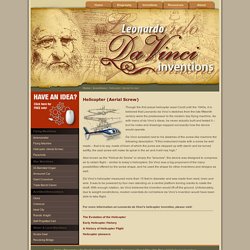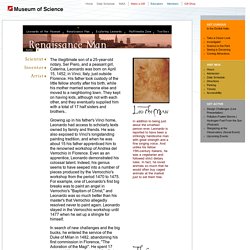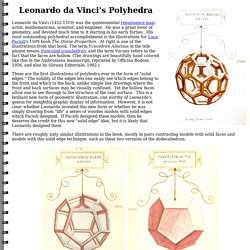

Timeline JS3 - Beautifully crafted timelines that are easy, and intuitive to use. Design Challenges and Suggested Materials. Leonardo's Challenges Design a gripping device at the end of a rope that will automatically lock onto a load when it is lifted, but will automatically release when the load reaches its destination.

Design a machine to push away the scaling ladders of invaders trying to get inside a castle without exposing the castle dwellers to danger. Design a machine that allows a person to make giant wings flap by pedaling with his/her feet. Modern Challenges Design a machine that pours standard amounts of cereal and milk into a bowl. Be Inventive! String Masking tape Cardboard Plastic straws Dowels or pencils Weights Rubber bands Brass fasteners Pulleys or spools to make them from Pipe cleaners Small pieces of wood or craft sticks A variety of boxes for supports and containers Paper Glue Scissors. Leonardo da Vinci's Aerial Screw Invention. Though the first actual helicopter wasn’t built until the 1940s, it is believed that Leonardo da Vinci’s sketches from the late fifteenth century were the predecessor to the modern day flying machine.

The Beauty of Diagrams. Da Vinci's Vitruvian Man of math - James Earle. Letters to Leonardo Classroom Ideas. Leonardo da Vinci. The illegitimate son of a 25-year-old notary, Ser Piero, and a peasant girl, Caterina, Leonardo was born on April 15, 1452, in Vinci, Italy, just outside Florence.

His father took custody of the little fellow shortly after his birth, while his mother married someone else and moved to a neighboring town. They kept on having kids, although not with each other, and they eventually supplied him with a total of 17 half sisters and brothers.. Growing up in his father's Vinci home, Leonardo had access to scholarly texts owned by family and friends.
He was also exposed to Vinci's longstanding painting tradition, and when he was about 15 his father apprenticed him to the renowned workshop of Andrea del Verrochio in Florence. Even as an apprentice, Leonardo demonstrated his colossal talent. Vitruvian man proportions. The Vitruvian Man's proportions The Vitruvian Man is a world-renowned drawing created by Leonardo da Vinci around the year 1487.

It is accompanied by notes based on the work of the famed architect, Vitruvius Pollio. The drawing, which is in pen and ink on paper and measures 34.4 cm × 25.5 cm (13.5 in × 10.0 in), depicts a male figure in two superimposed positions with his arms and legs apart and simultaneously inscribed in a circle and square. Fun with Mona Lisa – Art Projects for Kids. Lessons - Z01: Nose Study (Leonardo da Vinci) Leonardo da Vinci Quotes. Drawspace.com - Lessons - Z01: Nose Study (Leonardo da Vinci) Classroom Activity: Sketching Gadget Anatomy.
Main Idea: Close observation and sketching lead to a better understanding of how machines work.

Learning Objectives: Observe a machine closely from several angles while it operates. Identify the elements of machines combined in different gadgets. Show how the moving parts in machines relate to and affect each other. Create a clear diagram of how a machine works. Materials: paper pencils with erasers printed copies of the Inventor's Toolbox pages for reference. a selection of small machines with visible working parts (the more you have, the better): egg beater, cork screw, car jack, can opener, garlic press, tongs, monkey wrench, hand drill, Vise-Grips, the mechanism from a music box, wind up toy, pencil sharpener, stapler.
Ask students to get their parents involved in helping them locate examples of machine diagrams from home. Leonardo's Perspective. During the Renaissance, European artists began to study the model of nature more closely and to paint with the goal of greater realism.

They learned to create lifelike people and animals, and they became skilled at creating the illusion of depth and distance on flat walls and canvases by using the techniques of linear perspective. Background: Painting in the Middle Ages. Leonardo da Vinci trained as a painter during the Renaissance and became a true master of the craft. His amazing powers of observation and skill as an illustrator enabled him to notice and recreate the effects he saw in nature, and added a special liveliness to his portraits. Curious as well as observant, he constantly tried to explain what he saw, and described many experiments to test his ideas. Looking Through Leonardo's EyesLeonardo's Window Classroom Activity: Using Leonardo's WindowExploring Linear PerspectivePlaying Around with Size and Distance Classroom Activity: How Far?
Leonardo da Vinci's Polyhedra. Leonardo da Vinci (1452-1519) was the quintessential renaissance man: artist, mathematician, scientist, and engineer.

He was a great lover of geometry, and devoted much time to it starting in his early forties. His most outstanding polyhedral accomplishment is the illustrations for Luca Pacioli's 1509 book The Divine Proportion. At right is one of the illustrations from that book. Mona Lisa Lesson Plan. No wonder the theft of the Mona Lisa caused such frenzy and misguided suspicions when it was stolen in 1911.

It is one of the most well known paintings in the world, and one that seems to have universal appeal. Why is this painting still as revered and coveted today as the day it was stolen, or as when it was first painted? When people from different cultures or time periods share an understanding of an image, that image can be considered an icon. In this lesson, students will investigate the question, "What is an icon?
" They will compare their impressions and interpretations of the Mona Lisa to the hypothetical opinions of other people affected by this painting. Grade Level: Middle and High School Subject Areas: Visual Arts, History Lesson Length: one to two class periods Learning Goals Students will: Mona Lisa’s Smile. Mona Lisa, by Leonardo da Vinci Visitors to the Louvre Museum in Paris inevitably make their way up the stairs to the gallery where one of the most famous paintings in western art hangs: the Mona Lisa.

People over the centuries have delighted in the woman's coy smile. In this Science Update, you'll hear what the Mona Lisa's been hiding all these years. Transcript.